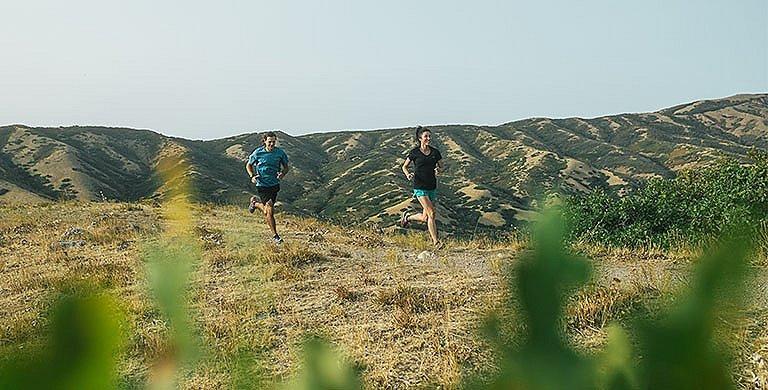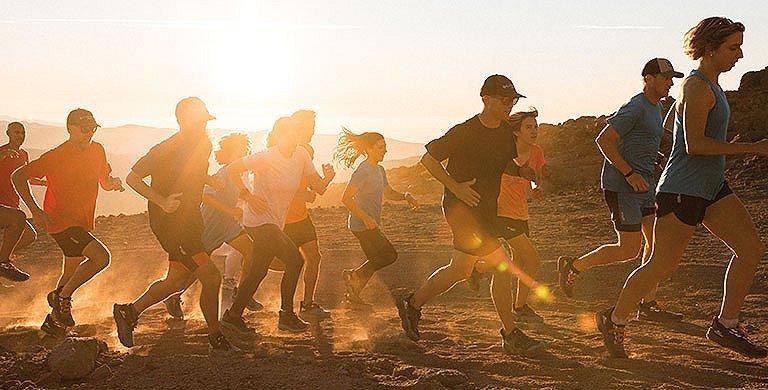TRAIL RUNNING
How to Get Started Running
Revving up the mind and body: the transformative power of running
BY: NANCY BOUCHARD
Running isn’t just a sport—it’s a lifestyle. Whether you're jogging, slogging, or crushing miles, the moment you lace up your shoes and hit the trail, you're joining a passionate, global community. From your first run-walk around the block to tackling tempos, track sessions, or meditative miles, running evolves with you. It can be a personal journey toward health, happiness, or competition, or simply the pursuit of that transcendent runner’s high.
A Sport Where Every Surface is a Trail
Every outdoor activity has its natural terrain. Climbers scale craggy peaks, hikers wander winding trails, and skiers carve S-turns through snow-laden slopes. But for runners, every surface is a trail. Whether it's city sidewalks, park paths, rugged mountain terrain, sandy beaches, or remote backcountry routes, the world is your playground. The beauty of running rests in its simplicity—you can run anywhere, anytime. Each mile is a victory, a triumph over the voice in your head telling you to stop and go back to the couch. Whether you're jogging around the block or prepping for an ultra, it’s all about the journey.
Running: A Primal Instinct
As Tim Evens, MS DPT (Master’s of Science, Doctor of Physical Therapy), and seasoned long-distance runner, puts it, “Running is the most primal human form of exercise. Humans are designed to run long distances—slowly, perhaps, compared to other animals, but we're built for it.” If you’re feeling the itch to start running, the best way is to begin by walking briskly for 20–30 minutes, and every five minutes, try a light jog for about one minute. Gradually build up to alternating between walking and light jogging, increasing the time you spend running as you go.
So, run like you were born to—it's in your DNA.
So, run like you were born to—it's in your DNA.
Slow and Steady Wins the Run
There’s power in gradual progress, so pace yourself. If you're a beginner or re-entering the sport, start slow. Evens says that running 20-30 minutes per week is a good starting point, and you should aim to increase your running volume by no more than 20% each week. He notes that if you've been strength training or doing plyometric exercises like jump squats or box jumps, your body might already be better conditioned to handle the impact of running. There’s no shortage of open-source training plans online that can guide you toward your distance goal, whether you're aiming for a 5K or even an ultramarathon.
A lot of people worry that their body isn’t designed for running. Evens points out that if you’ve been dealing with pain that has limited your ability to run, experimenting with different running styles might be the key to finding a movement pattern that works with your body. “Keep in mind that many ultramarathoners finish their races with significant osteoarthritis, yet they still manage long distances. If you're over 40, osteoarthritis is a common reality, but don’t let that deter you. Proper form, pacing, and gradual progression are essential to avoiding injury and building up to longer runs.”
A lot of people worry that their body isn’t designed for running. Evens points out that if you’ve been dealing with pain that has limited your ability to run, experimenting with different running styles might be the key to finding a movement pattern that works with your body. “Keep in mind that many ultramarathoners finish their races with significant osteoarthritis, yet they still manage long distances. If you're over 40, osteoarthritis is a common reality, but don’t let that deter you. Proper form, pacing, and gradual progression are essential to avoiding injury and building up to longer runs.”
Run For Your Life
Running isn’t just about getting out of the house, burning calories or hitting a specific time—it's about the long-term benefits. Physically, it boosts your heart health, improves circulation, reduces the risk of cardiovascular diseases, and helps lower blood pressure. Over time, running strengthens your lungs, increases stamina, and improves joint health.
But as any runner knows, the benefits go beyond the physical. Mentally, running can be a game-changer. It sharpens focus, reduces stress, and gives you a much-needed mood boost. Many runners experience a surge of energy after a morning run, setting a positive tone for the day ahead. Or their evening run becomes a touchstone of community or solace after a long day at work or school. Running helps you sleep better, feel better, eat better, and even improve your social life. What's not to love?
But as any runner knows, the benefits go beyond the physical. Mentally, running can be a game-changer. It sharpens focus, reduces stress, and gives you a much-needed mood boost. Many runners experience a surge of energy after a morning run, setting a positive tone for the day ahead. Or their evening run becomes a touchstone of community or solace after a long day at work or school. Running helps you sleep better, feel better, eat better, and even improve your social life. What's not to love?
Start Small, Dream Big
Remember that you own the run, not the other way around. Running is a personal victory, even when you have a training partner or full-on club behind you. For those new to running, start small and manageable. A beginner-friendly approach is alternating walking and running, gradually building up your endurance. Make your running schedule something you can realistically stick to. Consistency is key—don’t worry about speed or distance right away. Instead, focus on building the habit. Lay out your running gear the night before as a gentle reminder or connect with friends to plan. Soon enough, you’ll look forward to your runs.
To see the best results, consistency is key. This doesn’t mean you need a strict schedule, but sticking to regular running sessions will help you see improvement over time. A consistent routine builds momentum, making running feel more like a natural part of your life.
To see the best results, consistency is key. This doesn’t mean you need a strict schedule, but sticking to regular running sessions will help you see improvement over time. A consistent routine builds momentum, making running feel more like a natural part of your life.
Listen to Your Body Talk
Tune in to how your body feels during and after runs. Cramping, aches, or pain can signal that your body needs rest or better nutrition. Remember, in running—as with any sport—food is fuel. Cory Smith, Founder and Coach of Run Your Personal Best, says that nutrition an absolutely essential to run at your best. Food, particularly carbs, provide the fuel for higher intensity running, while protein aids in recovery from your runs. Ideally, it's best to get your nutrition from natural foods, but if you find you're unable to hit your required fueling needs with natural food alone, supplementation is a great alternative. Hydration is just as critical. As author Haruki Murakami, an avid runner himself, wisely puts it, “Pain is inevitable. Suffering is optional.”
Healthy Strides: Form, Recovery, and the Art of Rest
Proper form is crucial for avoiding injury, but it’s important to remember that everyone’s body is different. Cory Smith notes that while there is no one-size-fits-all perfect running form, there are key elements people can aim for. “Things such as landing underneath your center of gravity and maintaining a 90-degree perpendicular angle between your shin and the ground at the moment of impact are important aspects of proper running form,” Smith explains. “In general, beginners should focus more on developing the strength to maintain good running form, rather than perfecting it right away. Often, runners lack the strength needed to hold proper form, so building that base strength is essential.”
Smith also emphasizes that developing running form can happen naturally through running itself. “In general, keep your posture upright but relaxed, with your head looking forward—not down at your feet. Shoulders should stay relaxed, arms should swing forward, and your motion should feel smooth. Like with anything, your technique will improve over time and miles.”
Rest days are as important as training days, and sometimes harder to enforce. Don’t be afraid to take time off, especially if you’re feeling tired or sore. Active recovery and stretching will help keep you in top shape.
Smith also emphasizes that developing running form can happen naturally through running itself. “In general, keep your posture upright but relaxed, with your head looking forward—not down at your feet. Shoulders should stay relaxed, arms should swing forward, and your motion should feel smooth. Like with anything, your technique will improve over time and miles.”
Rest days are as important as training days, and sometimes harder to enforce. Don’t be afraid to take time off, especially if you’re feeling tired or sore. Active recovery and stretching will help keep you in top shape.
Measure Your Miles; Motivate Your Mind
While it’s never a great idea to get caught in the weeds with data, run-tracking apps can be a fun way to stay motivated, monitor progress, and connect with a larger community. These apps track mileage, pace, fitness stats, and map your runs. Or you can opt for a running-specific watch that delivers all the data you need to push your performance—literally at your fingertips—and is lighter, sleeker, and higher-performing than ever. These watches act as a coaching tool for those who want to track and visualize their progress.
Of course, running can always be about the joy of the run itself—no watch or specific goal required. But if you're looking to track, target, or train with purpose, running-specific watches, training apps, and social networks for runners can provide all the inspiration and motivation you need to keep pushing forward.
Of course, running can always be about the joy of the run itself—no watch or specific goal required. But if you're looking to track, target, or train with purpose, running-specific watches, training apps, and social networks for runners can provide all the inspiration and motivation you need to keep pushing forward.
Running Gear
Picking the Perfect Shoe
Running is one of the simplest sports—and one you can do on a shoestring budget (pun intended)—but the right gear can make a big difference. The foundation of your running wardrobe starts with a great pair of shoes. The right shoes—a perfect balance of comfort and performance in a lightweight package—can make or break a run. The right pair of running shoes should feel comfortable right out of the box.
Pro Tip: Lacing is a critical part of fit. Take the laces completely out of the shoes, then replace them while your foot is inside. This allows the shoe to conform to your specific foot shape. Also, your shoe/sock combination matters. Pick a thin, synthetic sock that doesn’t pinch or bunch, and be sure to dry both shoes and socks out between runs.
Many dedicated runners rotate between two or three pairs of shoes. As you gain experience, you'll learn which shoes work best for different surfaces—road vs. trail, for example—and for different distances. Some prefer more cushioning, while others go for less. But, more importantly, choose a shoe that’s light, with solid grip and the durability to go the distance.
Pro Tip: Lacing is a critical part of fit. Take the laces completely out of the shoes, then replace them while your foot is inside. This allows the shoe to conform to your specific foot shape. Also, your shoe/sock combination matters. Pick a thin, synthetic sock that doesn’t pinch or bunch, and be sure to dry both shoes and socks out between runs.
Many dedicated runners rotate between two or three pairs of shoes. As you gain experience, you'll learn which shoes work best for different surfaces—road vs. trail, for example—and for different distances. Some prefer more cushioning, while others go for less. But, more importantly, choose a shoe that’s light, with solid grip and the durability to go the distance.
Runway Ready: Apparel that Moves You
If you look good, you’ll feel good. And that counts a lot when you’re digging deep for motivation for your next training run. The good news is that running shorts and running shirts are better looking and more comfortable than ever. Lightweight, moisture-wicking materials prevent chafing. And sizing is much better than ever. Layering is important, as you’ll warm up quickly once you get going. Bright colors are a smart choice, as they increase visibility, especially if you're running at night or low-light conditions. Thanks to innovative fabrics, thermoregulating materials, high level sun protection and moisture management and advanced manufacturing techniques like sonic welding and laser cutting, fit and sizing is better and more inclusive than ever. With designs that cater to all body types, there’s something for everyone. Whether you’re looking for a snug fit or a little extra room, modern gear is made to move with you—no matter your shape or size.
Running accessories like headbands, hydration packs, and running caps aren’t essential to get started, but they can definitely come in handy. Keep it simple at first—focus on enjoying the run—but as you get more into it, you'll quickly find yourself with a full kit, from reflective gear and running lights to cozy, lightweight pullovers, gloves, and hats to match the season.
Running accessories like headbands, hydration packs, and running caps aren’t essential to get started, but they can definitely come in handy. Keep it simple at first—focus on enjoying the run—but as you get more into it, you'll quickly find yourself with a full kit, from reflective gear and running lights to cozy, lightweight pullovers, gloves, and hats to match the season.
The Art of Going the Distance
To run longer and faster, focus on gradually building endurance. Start with shorter distances at a comfortable pace, then slowly increase your mileage over time. You’ll want a mix of slow and faster runs, even if you’re working on a PR—personal record.
Interval training and speed workouts are great tools for improving your pace and stamina. These sessions alternate between fast and moderate speeds, helping you build endurance and boost your performance.
But in the long run, consistency is more important than speed. If fact, marathon training courses stress slow or tempo runs. Supplement your running with strength training and cross-training activities like cycling, climbing, swimming or hiking.
Interval training and speed workouts are great tools for improving your pace and stamina. These sessions alternate between fast and moderate speeds, helping you build endurance and boost your performance.
But in the long run, consistency is more important than speed. If fact, marathon training courses stress slow or tempo runs. Supplement your running with strength training and cross-training activities like cycling, climbing, swimming or hiking.
The Wall Is Just a Speed Bump-Staying Psyched
Everyone faces motivation slumps, even the most dedicated athletes. Running is a long-term commitment, so be kind to yourself when the energy dips. Some days, you’ll feel like you’re flying; other days, slogging through the mud. Both are part of the journey. When lethargy hits, set a new challenge, or treat yourself to some drool-worthy new gear as a reward.
Joining a running group or club can provide a serious boost of motivation to your routine. As Smith explains, “Running can be whatever you make of it. While it may seem like a simple sport where all you need to do is head out the door and run, training can be quite complex. Factors such as how much to run, how often, and how fast are all crucial elements that need to be individually optimized to get the most out of your running while staying healthy. Having someone knowledgeable in these areas can fast-track your improvement and help you stay injury-free.”
But it’s also about camaraderie. Finding running partners can be tough, especially if you’re a faster runner. A running club provides community. Whether you’re running for fun or racing to break a personal record, a supportive group can make all the difference. Check your area for local running clubs—many are organized by running stores, outdoor shops, or schools. You'll find a like-minded people of all ages, abilities, and backgrounds, ready to support you on your running journey.
Joining a running group or club can provide a serious boost of motivation to your routine. As Smith explains, “Running can be whatever you make of it. While it may seem like a simple sport where all you need to do is head out the door and run, training can be quite complex. Factors such as how much to run, how often, and how fast are all crucial elements that need to be individually optimized to get the most out of your running while staying healthy. Having someone knowledgeable in these areas can fast-track your improvement and help you stay injury-free.”
But it’s also about camaraderie. Finding running partners can be tough, especially if you’re a faster runner. A running club provides community. Whether you’re running for fun or racing to break a personal record, a supportive group can make all the difference. Check your area for local running clubs—many are organized by running stores, outdoor shops, or schools. You'll find a like-minded people of all ages, abilities, and backgrounds, ready to support you on your running journey.
Whether you're cruising a casual jog or pushing for a personal best, make sure your feet—and style—are covered with Columbia’s
running footwear and apparel.



